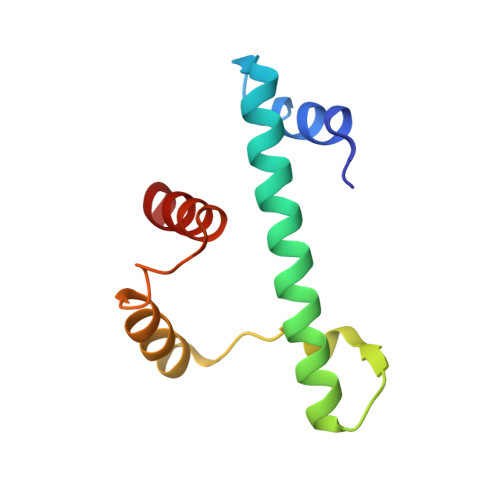DNA-bridging by an archaeal histone variant via a unique tetramerisation interface.
Ofer, S., Blombach, F., Erkelens, A.M., Barker, D., Soloviev, Z., Schwab, S., Smollett, K., Matelska, D., Fouqueau, T., van der Vis, N., Kent, N.A., Thalassinos, K., Dame, R.T., Werner, F.(2023) Commun Biol 6: 968-968
- PubMed: 37740023
- DOI: https://doi.org/10.1038/s42003-023-05348-2
- Primary Citation of Related Structures:
8BDK - PubMed Abstract:
In eukaryotes, histone paralogues form obligate heterodimers such as H3/H4 and H2A/H2B that assemble into octameric nucleosome particles. Archaeal histones are dimeric and assemble on DNA into 'hypernucleosome' particles of varying sizes with each dimer wrapping 30 bp of DNA. These are composed of canonical and variant histone paralogues, but the function of these variants is poorly understood. Here, we characterise the structure and function of the histone paralogue MJ1647 from Methanocaldococcus jannaschii that has a unique C-terminal extension enabling homotetramerisation. The 1.9 Å X-ray structure of a dimeric MJ1647 species, structural modelling of the tetramer, and site-directed mutagenesis reveal that the C-terminal tetramerization module consists of two alpha helices in a handshake arrangement. Unlike canonical histones, MJ1647 tetramers can bridge two DNA molecules in vitro. Using single-molecule tethered particle motion and DNA binding assays, we show that MJ1647 tetramers bind ~60 bp DNA and compact DNA in a highly cooperative manner. We furthermore show that MJ1647 effectively competes with the transcription machinery to block access to the promoter in vitro. To the best of our knowledge, MJ1647 is the first histone shown to have DNA bridging properties, which has important implications for genome structure and gene expression in archaea.
- Institute for Structural and Molecular Biology, Division of Biosciences, University College London, Darwin Building, Gower Street, London, WC1E 6BT, UK.
Organizational Affiliation:
















